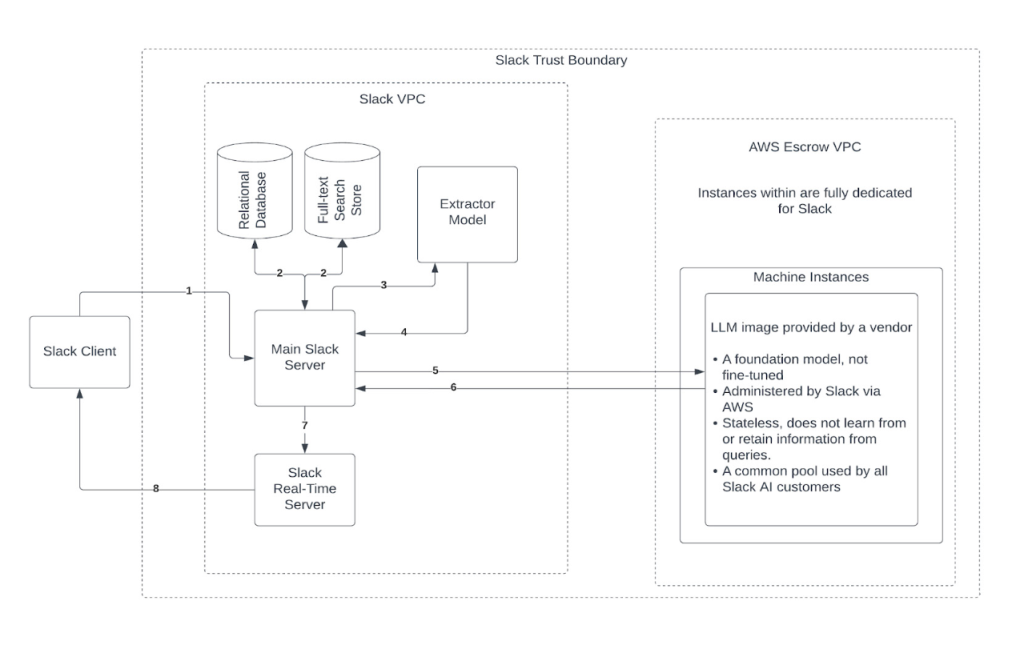
In our “Engineering Energizers” Q&A series, we highlight engineering leaders tackling some of the toughest challenges in AI and enterprise software. Today, we feature Curtis Allen, Backend Senior Staff Engineer at Slack AI. Curtis’ team is at the forefront of developing AI-driven solutions to improve how users find, process, and summarize information.
Discover how Curtis and his team successfully integrated Slack AI with Agentforce, optimized AI search and summarization at scale, and reduced infrastructure costs while handling billions of messages.
What is your team’s mission?
Our mission is to boost Slack users’ productivity by helping them find, process, and summarize information more efficiently. One of the biggest challenges users face is information overload—returning to Slack after time away and struggling to catch up on important discussions. Slack AI is designed to eliminate this friction, allowing users to quickly understand what they missed without manually scrolling through numerous messages. To achieve this, our team is structured into four key areas:
- AI-Powered Search – Enhances Slack’s search capabilities with ranking optimizations, relevance tuning, and AI-powered query interpretation.
- AI Search Answers – Uses advanced techniques to generate natural language responses to search queries, making search more interactive and context-aware.
- Signature AI Features – Develops core AI functionalities like Slack AI Recaps, Thread Summarization, and Huddle Note-Taking, which automate summarization and information retrieval.
- AI Enablement – Provides SDKs and internal tools that allow other Slack teams to integrate AI into their products.
This structure ensures that Slack AI can focus on both improving foundational search features and delivering cutting-edge AI experiences, seamlessly integrating AI into users’ workflows without adding unnecessary complexity.
Curtis describes the engineering culture at Salesforce.
What were the biggest engineering challenges in building Slack AI’s features?
Each AI-powered feature in Slack presented unique engineering hurdles.
- Slack AI Recaps: The challenge was processing billions of messages to generate meaningful summaries without significantly increasing infrastructure costs. The team batch-processed recaps overnight, offloading heavy AI tasks from peak usage hours and ensuring fresh summaries each morning.
- AI Search Answers: Unlike traditional keyword-based search, AI-powered search needed to return direct, contextually accurate answers. The main challenge was prompting the model to distinguish relevant from irrelevant messages in long, complex threads. The team developed a custom ranking system that combines Slack’s internal search signals with AI reasoning to generate concise and precise answers.
- AI Thread Summarization: Handling unstructured, multi-speaker conversations was the toughest problem. Many threads lack a strict question-and-answer format, making it hard to identify key points. The team refined the output by weighting important message types (e.g., decision points, action items, and high-reaction messages) more heavily and deprioritizing off-topic or redundant responses.
Building these features required careful tuning of AI models, optimizing processing efficiency, and ensuring that AI-generated insights were trustworthy for enterprise users.

Slack AI architectural diagram, describing how Slack uses LLMs.
How did your team overcome the challenge of scaling Slack AI to support billions of messages while optimizing for cost efficiency?
Running LLM inference on every Slack message would have been too expensive. The team developed a tiered AI processing model to balance real-time responses with batch processing. Here are the key strategies:
- Concurrency Slot System for Real-Time AI Calls: A rate-limiting system was built to prioritize high-value queries and execute them based on available processing slots. This keeps real-time search answers and thread summarizations fast while preventing system overload.
- Batch Processing for Slack AI Recaps: Recaps are precomputed overnight, spreading out AI workloads and ensuring fresh summaries while avoiding expensive compute spikes.
- Token Optimization to Reduce LLM Compute Costs: The team optimized token usage by reducing redundant AI calls and fine-tuning query efficiency. This cut inference costs while maintaining high-quality responses.
Curtis explores some emerging tools that his Slack AI team uses.
How is your team making Slack AI more proactive and intelligent through ongoing research?
Slack AI is evolving to anticipate user needs. Here’s how:
- Agentic Workflows: We are researching workflows that allow AI to automatically track tasks, recommend experts, and highlight trends. This means AI will proactively help users manage their workflow instead of waiting for them to search for information.
- Integration with Agentforce: Slack AI will detect when a conversation needs deeper business intelligence and seamlessly hand it off to Salesforce AI assistants, creating a unified, AI-driven experience.
- Proactive Intelligence: By moving from passive interactions to proactive assistance, we aim to make Slack AI an active collaborator in enterprise productivity, not just an information-finding tool.
Looking forward, what will be the toughest engineering obstacles for integrating Slack AI with Agentforce?
Integrating Slack AI with Salesforce’s Agentforce isn’t just about connecting two APIs; it involves tackling some of the most complex engineering challenges in AI system interoperability. Slack AI is designed to handle all the data you input into Slack, including messages, files, and system events, whereas Agentforce operates within structured business intelligence workflows. The primary challenge is to ensure that the transitions between the two AI systems are seamless and contextually relevant.
One significant hurdle is determining when a Slack user would benefit more from an Agentforce agent. Slack AI can facilitate this handoff by providing rich context from CRM data, ensuring the user’s goal is seamlessly transferred to an Agentforce agent. This collaboration will enable Slack AI to provide the right information at the right time, enhancing the user experience.
By addressing these challenges, the integration will create a smooth transition between conversational Slack AI interactions and structured Salesforce AI intelligence, making AI-powered business workflows more natural and efficient. Since we spend a significant portion of our work lives in Slack, Agents can leverage Slack as a collaboration platform, not only with other agents but also with users.
Learn more
- Stay connected — join our Talent Community!
- Check out our Technology and Product teams to learn how you can get involved.






